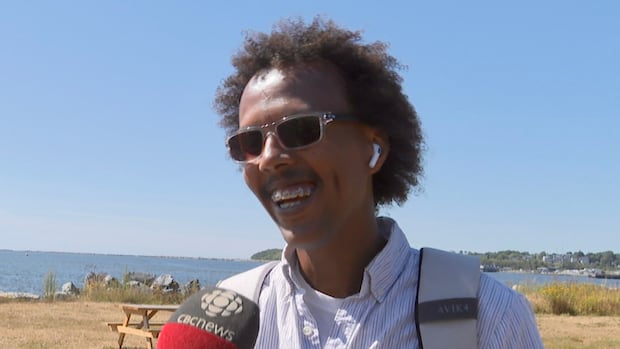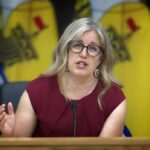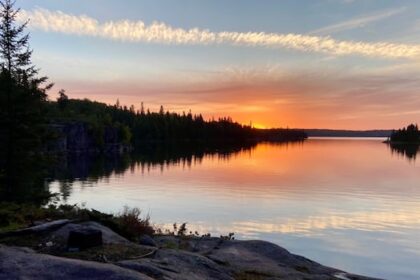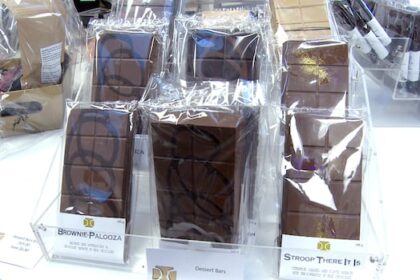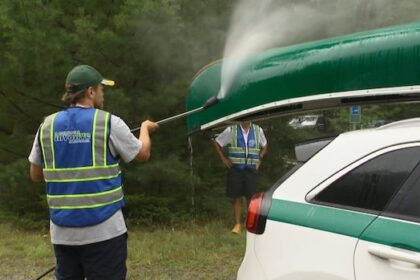While on vacation from British Columbia, Abdel Mustafa noticed something as he wandered around Saint John.”I barely saw any parks,” he said. “In Vancouver, we have a lot of green spaces everywhere.”Statistics Canada backs up Mustafa’s observation.During the 2021 census, 81 per cent of Saint Johners reported having a park or green space within 10 minutes of their home — putting Saint John dead last among Canadian cities.By contrast, Hamilton, Ont., topped the list with 97 per cent of respondents saying they had a park or green space nearby.At 87 per cent, Moncton came in 32nd out of the 35 metropolitan areas (CMAs) that were recognized in the 2021 census. Fredericton was not ranked since it only met the criteria to become a CMA in 2021. Most pronounced in urban coreWhile the City of Moncton reports 7.6 per cent of the city’s total area is parkland, and the City of Fredericton pegs it at six per cent, in Saint John, it’s just 3.8 per cent.The shortfall is even greater in the urban core, known as the south central peninsula, where parks make up just 2.1 per cent, according to data from the city.WATCH | Saint John is lacking green space. Here’s why it matters:When it comes to green space, Saint John ranks last in the countryAccording to Statistics Canada, just 3.8 per cent of land in the port city is covered by parks, and that has implications for individual and community health. “That doesn’t surprise me,” said UNB Prof. Hepzibah Muňoz Martinez, whose research focuses on urban politics and critical geography.The south end resident said her team surveyed people in that community about access to natural areas and found having few parks nearby is especially hard on seniors, youth and newcomers.”You need those kinds of green spaces for people to socialize, to be outside with their families, to start getting settled in a new context, to deal with mental health issues,” she said.Transportation barriers The south central peninsula has a high concentration of low-income households, with parts of the south end and Waterloo village seeing poverty levels as high as 70 per cent.Muňoz Martinez said that means a lot of people in the urban core don’t have a vehicle, leaving Rockwood Park’s 890 hectares — making it one of the largest municipal parks in the country — out of reach.There’s no direct bus route to Rockwood from the south end. Walking takes about 40 minutes and you have to cross a major highway.UNB Prof. Hepzibah Muňoz Martinez led a research team that surveyed residents in Saint John’s south end and learned many people in the low-income neighbourhood rely on parks for socialization, which benefits mental health. (Graham Thompson/CBC)Muňoz Martinez remembers what that was like, when she moved from Mexico and didn’t have a car.”To access that space by public transit or by bike was really difficult,” she said. “Even to get to that pathway that crosses the highway was really dangerous.”Temperature risingACAP Saint John, a non-profit, environmental group, is using an infrared drone to map Saint John’s urban heat islands in the south central peninsula, old north end, lower west side and McAllister neighbourhoods.The group said preliminary mapping suggests sparse green space is driving up the heat.”We’ve seen temperatures as high as 50 to 60 C on surfaces like backstreet roads that have been sitting in the sun,” said Jack Quirion, a biologist and ACAP’s climate change projects co-ordinator.”Meanwhile, shaded spaces under trees can be as low as 20 C or lower,” he said. “The effect of trees in cooling cities is an astronomical impact.”ACAP Saint John staff members Jack Quirion and Laura Hunt use an infrared drone to map the heat island effect in some of the city’s highly paved neighbourhoods. (Submitted)Meanwhile, Saint John’s public green space has been shrinking.A huge chunk of Rainbow Park in the south end has been ripped up to build a new school, and last fall, the city declared five hectares of Rockwood Park surplus, opening the door for development.City council also came close to reaching a deal with J.D. Irving Ltd. last spring to turn a third of the west side’s Wolastoq Park into a parking lot.Quirion said adding green space would help the community fight climate change.And there are a lot of parking lots and brown fields, which are abandoned tracts of land once used for industry, that could be turned into parks, he said.”Given its dense population compared to other places in Saint John, [the south central peninsula] might be more in need of it on a per person basis.”City responseSaint John councillor-at-large Brent Harris agrees — in theory.”There’s a lot down here off the corner of Mecklenburg, there’s an empty lot over here on Queen Street,” he said, standing on a corner in the south end. Harris has been placing planters in highly paved neighbourhoods, in a project with the non-profit Saint John Tool Library, which he runs.City councillor-at-large Brent Harris likes the idea of turning vacant lots into mini parks, but said citizen support would be needed to get those kinds of initiatives started. (Graham Thompson/CBC)But he said greening up bigger spaces, by turning vacant lots into parkettes, would be a lot more challenging.”There’s multiple holders of land that are not the municipality, that we have no control over,” he said, noting some areas are controlled by the provincial or federal governments.Harris said council has asked the province to adjust the Local Governance Act to allow the city to expropriate vacant properties where taxes have gone unpaid.But he said even if the city were able to reclaim that underused space, council would likely turn it into housing, not parks.Given the barriers, Harris said residents who want more green space need to step up and demand it, pointing to recent public outcry that forced the province to cancel daytime lane closures during construction on the Harbour Bridge.”When you start to see 20-30 people talking about the same problem that has pretty simple solutions, that’s when you start to see change.”So far, Harris said constituents haven’t been asking for more parks.”When you’ve lived around this your whole life, it seems normal,” Harris said, pointing around at the concrete. “Until you travel to almost every other city, especially capital cities.”Possible solutionsRetired UNB biologist Steve Heard said Saint John could look to Fredericton for solutions.The Botanic Garden, located at the west end of Odell Park, which was established in 1990 after citizens approached Fredericton city council about a vacant parcel of land. An active member of the garden’s board, Heard said the city supports the non-profit park with funding and maintenance.”There are other examples like that in cities around the world, where you have gardens or other green spaces maintained by community groups alongside the local government.” Heard said Saint Johners could begin on a smaller scale.”Even small plantings of wildflowers can increase populations of pollinators like butterflies and bees,” he said.”You can use all kinds of really inventive ways to carve out small green spaces that make a difference.”
Saint John ranks last among all cities in Canada for access to green space
